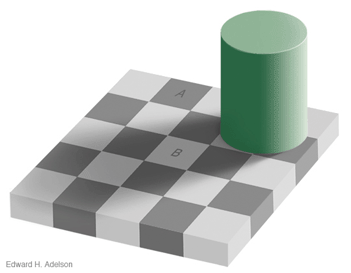Each point in a visual scene sends light of particular intensities and wavelengths to your eyes. What you see, however, is not the actual intensities and wavelengths reaching your eye, as they would be measured by a photocell. Instead, your retina and brain pay most attention to edges, places in the scene where there are sharp changes in intensity and/or wavelength. Your brain makes "informed guesses" about the intensity and wavelengths of light coming from points between edges. These informed guesses are based on, among other things, the intensities and wavelengths of light coming from other locations in the scene blindspot. Hence the intensity and color of light coming from particular objects in the scene may change if the objects are moved. You can verify this in the two images to the right.
That what you see is an "informed guess" rather than what's "out there" is worth remembering if, for example, you want to know what a sofa you see in a store will look like in your living room, or you are an artist doing a painting. More generally, it is a good reminder that the brain has evolved not to represent "reality," but rather to construct for one a useful picture. The contrast and color effects illustrated here reflect the brain's effort to give you a consistent picture of objects, one that isn't constantly changing whenever the illumination changes.
|







